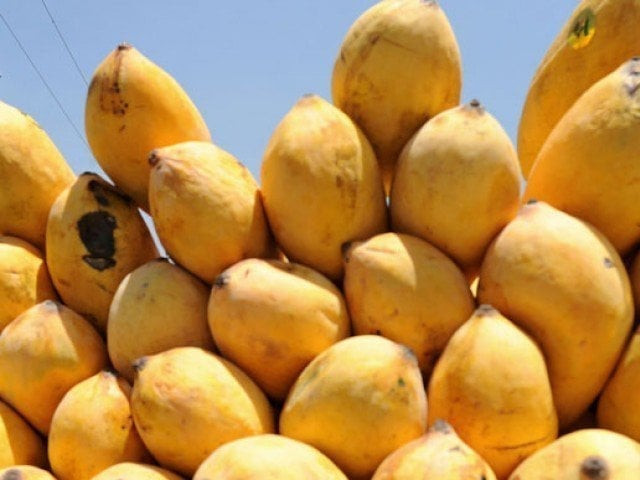
Now, Pakistani scholars’ findings have shed light on these qualities in the four popular mango varieties from different geographical locations.
Dr M Kamran Azim, the Dean of Life Sciences Faculty and the Head of Biosciences Department at the Mohammad Ali Jinnah University, led the team that sequenced some of the genes involved in aroma, taste and color of Langra (Pakistan), Zill (China), Shelly (Israel) and Kent (Mexico).
Pakistani mangoes set to enter Chinese market
The aim of the comparative study of different mango varieties was to find the common biomolecules. Interestingly, the team also found some very important medicinal properties in all varieties of mango.
Dr Waqasuddin Khan at the International Chemical and Biological Sciences (ICCBS) at Karachi University and Safina Abdul Razzak of Mohammad Ali Jinnah University were involved in the findings with lead author Dr Azim.
The paper entitled “Comparative Transcriptomics of Mango (Mangifera indica L) Cultivars Provide Insights of Biochemical Pathways Involved in Flavor and Color” has also been published online in a prestigious journal from Cold Spring Harbor Laboratory, USA.
Genomics and molecular data of mango was studied by scientists with the help of sophisticated computers and bioinformatic tools, which revealed valuable insights on the secrets of mango.
“Dozens of mango varieties are commercially grown in tropical and subtropical countries. However, complete genome information of mango is not available. Nonetheless, transcriptomics data, (the complete set of RNA transcripts expressed in a specific tissue under a particular condition), is available for some mango varieties,” said Dr Waqasuddin Khan while speaking to The Express Tribune.
“Using sophisticated Bioinformatics tools, we found some specific biomolecules that are responsible for flavor and color in mango fruits” added Dr Khan.
Digging into data
The team carefully extracted the genetic information from the mangoes which resulted in huge chunks of data even in Gigabytes. For instance, 30,953, 57,544, 58,797 and 85,036 of unigenes from Langra, Zill, Shelly and Kent were generated initially and then researchers further analysed the data to identify the molecules they were looking for.
Unigene is a complex term which often referred to a genetic data base called at NCBI.
“Once you have data to analyse, the real fun begins. Genomic data analyses deciphered the genes, their protein products, and their metabolic pathways (a series of chemical reactions which lead to useful compounds in living organisms ). The whole research itself paves multiple study projects where one could go for more interesting findings,” said Dr Khan.
The economic value of mangoes makes this fruit equally important at grocery stores and at research benches across the world. The Pakistani team identified many important genes and their pathways responsible for taste and aroma of the fruit.
The study shows that different complex biochemicals – terpenoids, flavonoids and carotenoids – are involved in the taste and aroma in mango varieties.
Flavonoids are the group of natural pigments that paint the fruits and flowers in beautiful colors. The team unveiled important flavonoids in all types of mangoes.
The healing mango
Mangoes are famous for their vitamins and minerals however they also have unique compounds against many bacterial and viral activities. Pakistani experts also found two important compounds named Lupeol and β-amyrin in Langra mango, which holds healing properties.
For instance, Lupeol has anti-inflammatory, anti-tumor and chemopreventive properties. On the other hand, β-amyrin has anti-inflammatory and hypolipideimic (fat lowering) effects.
Deciphering the mango secrets is passion for Dr Azim as he reported mango chloroplast genome (the green plant cells) almost a decade ago. He also successfully identified a bacterium responsible for the infections of mango trees in Sindh. This observation study is as continuation of previous research projects on this fruit.
“The current paper has provided valuable data regarding the biochemistry of mango fruit grown in Pakistan as well as in China, Middle East and North America. Our previous research has been cited and referred by leading scientists across the world,” said Dr Azimtold The Express Tribune.
Harmful effects: PFA bans artificial ripening of fruit
Strengthening the research
According to United Nations Food and Agriculture Organization, India holds first position in mango production. China is on second while Pakistan and Mexico holds the fifth and sixth place, respectively.
Studies and research can grow Pakistan's production of this important cash fruit. Further funding is needed to continue this very important work. Fundings from the Pakistan Science Foundation (PSF), Higher Education Commission (HEC) and Pakistan Agriculture Research Council (PARC) can help the researchers to improve local varieties of mangoes.
















COMMENTS
Comments are moderated and generally will be posted if they are on-topic and not abusive.
For more information, please see our Comments FAQ